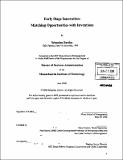| dc.contributor.advisor | Diane Burton. | en_US |
| dc.contributor.author | Bardon, Sebastien (Sebastien Remi) | en_US |
| dc.contributor.other | Sloan School of Management. | en_US |
| dc.date.accessioned | 2009-01-30T16:47:16Z | |
| dc.date.available | 2009-01-30T16:47:16Z | |
| dc.date.copyright | 2008 | en_US |
| dc.date.issued | 2008 | en_US |
| dc.identifier.uri | http://hdl.handle.net/1721.1/44442 | |
| dc.description | Thesis (M.B.A.)--Massachusetts Institute of Technology, Sloan School of Management, 2008. | en_US |
| dc.description | Includes bibliographical references (p. 91-93). | en_US |
| dc.description.abstract | What makes innovation happen in reality? The challenges companies have faced in building their competitive advantage have been shifting over the last decade, away from operational excellence and global footprint and towards innovation and learning. This thesis explores the interactions between new business opportunities and technological inventions during the early stages of breakthrough innovations in technology. Hypothesizing: a technological innovation is primarily a match between a new business opportunity and an invention. The literature review redacts the recent developments regarding ways of sourcing inventions, new ways to build business opportunities, and best practices for assessing innovation projects. The core of the thesis is a comparative analysis of the interactions between business opportunities and inventions in four different organizations: The Langer Lab at MIT, IDEO, The MIT innovation ecosystem, and LargeCo (a large multinational company whose name has been disguised). The analysis is conducted by describing each organization, gained through interviews and research, with specific attention to the source of inventions, the way new business opportunities are generated, and the dynamic interactions between inventions and opportunities. The analysis of the Langer Lab and IDEO suggests a possible blueprint for inventive organizations, it reveals the high level of attention both organizations pay to business opportunities, and it shows the critical role of the interactions between opportunities and inventions during the early stages of the innovation process. Similarly, the study of the MIT ecosystem unveils numerous mechanisms fostering those interactions at every stage of the innovation process. By contrast, the absence of entrepreneurial behaviors and the adversity of the organization to market-related risks seem to be hurdles to those interactions at LargeCo. | en_US |
| dc.description.statementofresponsibility | by Sebastien Bardon. | en_US |
| dc.format.extent | 93 p. | en_US |
| dc.language.iso | eng | en_US |
| dc.publisher | Massachusetts Institute of Technology | en_US |
| dc.rights | M.I.T. theses are protected by
copyright. They may be viewed from this source for any purpose, but
reproduction or distribution in any format is prohibited without written
permission. See provided URL for inquiries about permission. | en_US |
| dc.rights.uri | http://dspace.mit.edu/handle/1721.1/7582 | en_US |
| dc.subject | Sloan School of Management. | en_US |
| dc.title | Early stage innovation ; matching opportunities with inventions | en_US |
| dc.title.alternative | Early stage innovation in large companies : look for opportunities, not ideas | en_US |
| dc.type | Thesis | en_US |
| dc.description.degree | M.B.A. | en_US |
| dc.contributor.department | Sloan School of Management | |
| dc.identifier.oclc | 294909128 | en_US |

